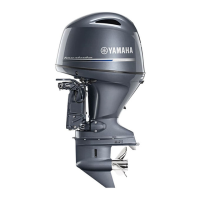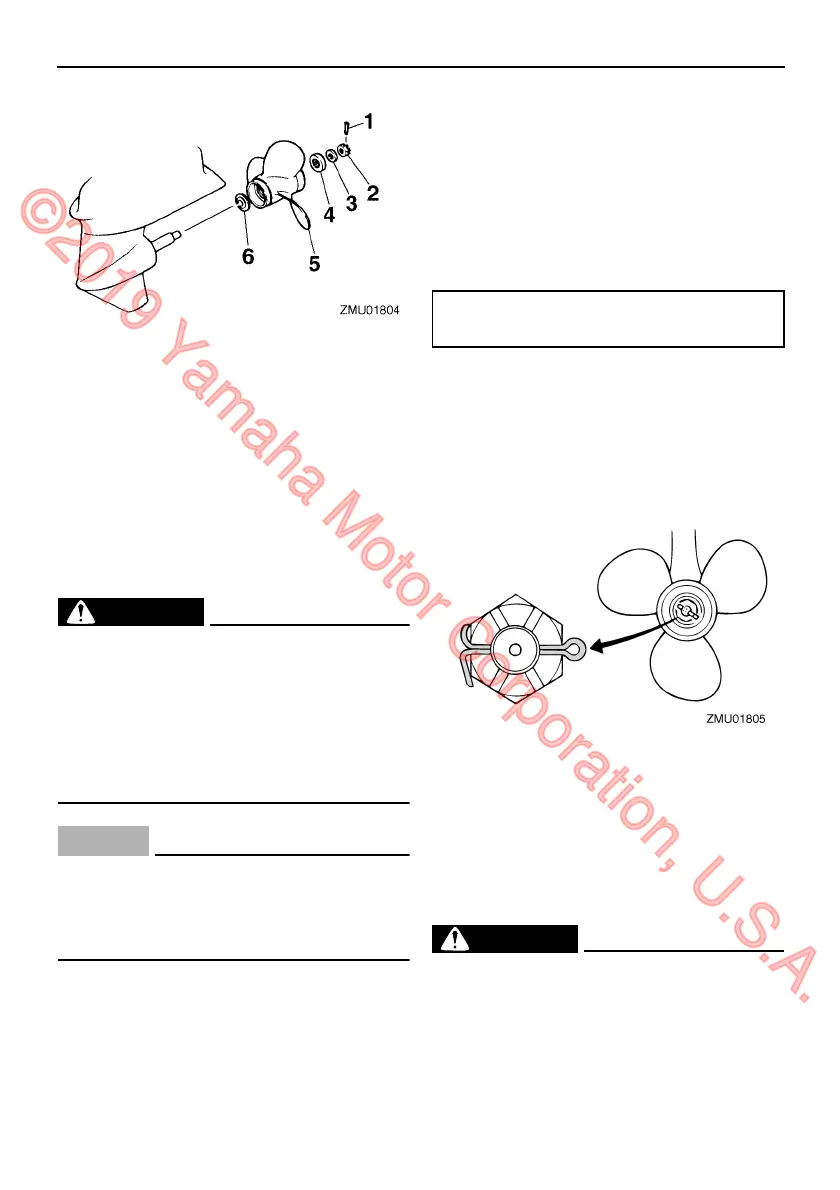
 Loading...
Loading...
Do you have a question about the Yamaha F115 and is the answer not in the manual?
| Displacement | 1832cc |
|---|---|
| Prop Shaft Horsepower | 115 hp |
| Alternator Output | 35 Amp |
| Gear Ratio | 2.15:1 |
| Starting System | Electric |
| Fuel Recommendation | Regular Unleaded (Minimum Pump Octane 87) |
| Oil Recommendation | Yamalube 4M |
| Exhaust | Through Propeller |
| Lubrication | Wet Sump |
| Steering | Remote |
| Cooling System | Water Cooled |
| Bore x Stroke | 81.0 x 88.9 mm |
| Full Throttle RPM Range | 5300-6300 rpm |
| Fuel Induction System | EFI (Electronic Fuel Injection) |
| Ignition System | TCI (Transistor Controlled Ignition) |
| Weight | 377 lbs |
| Cooling | Water Cooled |
| Shaft Length | L = 20 inch, X = 25 inch |
Introduction to the owner's manual and Yamaha outboard motor.
Explains the meaning of symbols, warnings, notices, and tips in the manual.
Key precautions for safe operation of the outboard motor.
Warnings and precautions related to the propeller and moving engine components.
Caution regarding hot engine parts and electrical shock risks.
Safety measures for trim/tilt systems and the engine shut-off cord.
Safe handling procedures for gasoline, its vapors, and spills.
Awareness of carbon monoxide risks from exhaust gases.
Discourages unauthorized modifications to the outboard motor.
General safety guidelines for responsible boating, including alcohol, PFDs, and collision avoidance.
Advice on weather, accident reporting, and importance of boating education.
Emphasizes obeying marine laws, understanding rules of the road, and navigation signals.
Explains rules for meeting, crossing, and overtaking other vessels.
Guidance on navigating channels, right-of-way for different vessels, and reading markers.
Recording and understanding motor serial numbers, key numbers, DoC, and CE marking.
Emphasizes reading all manuals and labels for safe operation.
Explains common symbols used in the manual and on the motor.
Detailed specifications including dimensions, weights, and performance.
Engine output power, idle speed, type, displacement, bore/stroke, and ignition.
Specifications for spark plugs and minimum battery requirements.
Recommended fuel types, octane, engine oil grades, and capacities.
Critical warnings and requirements for motor installation, including horsepower limits.
Information on the Yamaha Security System and remote control requirements.
Guidelines for safe battery mounting and connecting multiple batteries.
Guidance on propeller selection and understanding counter rotation models.
Explanation of start-in-gear protection and engine oil grade details.
Guidance on gasoline quality, octane, and warnings about ethanol.
Recommended fuel additives and importance of fuel filtration.
Advice on anti-fouling paint application and proper motor disposal.
List of essential items to keep onboard for emergencies.
Engine compliance with emission standards and CARB star label explanations.
Illustrated overview of outboard motor components and their identification.
Description of various instrument displays like tachometer and speedometer.
Information on the remote transmitter and receiver for the security system.
How to use the remote transmitter to lock/unlock the security system.
Details on operating the remote control box, lever, and associated switches.
Operation of neutral interlock, throttle lever, and free accelerator.
Operation of tiller handle and gear shift lever.
How to use the throttle grip and adjust its friction.
Proper use and inspection of the engine shut-off cord and stop button.
Operation of the main switch and adjustment of steering friction.
How to use the power trim and tilt switches located on the motor and controls.
Function and adjustment of the trim tab and use of the tilt support lever.
How to operate the cowling lock and use the flushing device.
Function of the fuel filter/water separator and its alert system.
Displays engine speed and trim angle, includes alert indicators.
Tracks engine operating hours, with trip and total hour displays.
Alerts for critically low oil pressure and high engine temperature.
Shows boat speed and indicates fuel level.
Displays trip distance, time, or battery voltage.
Alerts for low fuel level and low battery voltage.
Displays fuel consumption status, flow rate, and economy.
Introduction to various Command Link meter types.
Displays engine speed and includes multiple functions like trim and alerts.
Procedures for starting the engine and checking system status, including security system info.
Detailed explanation of various alert indicators like low oil and overheat.
Alerts for water in the fuel separator and engine malfunctions.
Functions of the Command Link speed and fuel meter.
Shows boat speed and allows unit selection.
Displays fuel flow, consumption, economy, and remaining fuel.
General information on the engine alert system.
Specific overheat alert information for twin engine setups.
Alerts for critically low engine oil pressure.
General guidance on installation and critical warnings about horsepower and mounting.
Guidelines for proper motor placement, balance, and mounting height.
Procedures for initial engine setup, filling oil, and breaking in the engine.
Essential checks to perform before starting the engine, including fuel level.
Steps for removing and correctly installing the engine top cowling.
Inspecting the fuel system for leaks and proper function.
How to operate various controls like tiller, remote, throttle, and shut-off cord.
Procedures for checking the engine oil level using the dipstick.
How to use the flushing device and install the cowling correctly.
Inspecting the power trim and tilt system for proper function.
How to adjust motor trim angle and boat trim for optimal handling.
Procedures for tilting the motor and operating in shallow water.
Advice for operating in salt water or water with debris.
Precautions for transporting and storing the motor.
Steps for properly storing the motor for prolonged periods.
How to flush the cooling system using the attachment.
Guidelines for lubricating parts and protecting against corrosion.
How to clean, inspect, and adjust spark plugs.
Step-by-step instructions for changing engine oil.
Inspecting, removing, and installing the propeller.
Instructions for changing the gear oil.
Inspecting anodes and checking the battery's condition.
Proper procedures for connecting, disconnecting, and storing the battery.
Common problems and their possible solutions for Yamaha outboard motors.
Diagnosing and resolving issues when the starter or engine won't start.
Troubleshooting rough idling, stalling, and reduced engine power.
Troubleshooting alerts from buzzers or indicators like low oil and overheat.
Immediate actions in emergencies, including impact damage.
Operating with one engine and replacing fuses.
Troubleshooting power trim/tilt issues and water separator alerts.
Instructions for starting the engine manually using an emergency rope.
Steps to take if the outboard motor is submerged.
Details of the limited warranty coverage for the outboard motor.
Lists warranty exclusions and information on emission control warranty.
Specific warranty considerations for use outside the USA or Canada.
Benefits of using genuine Yamaha parts, accessories, and fluids.